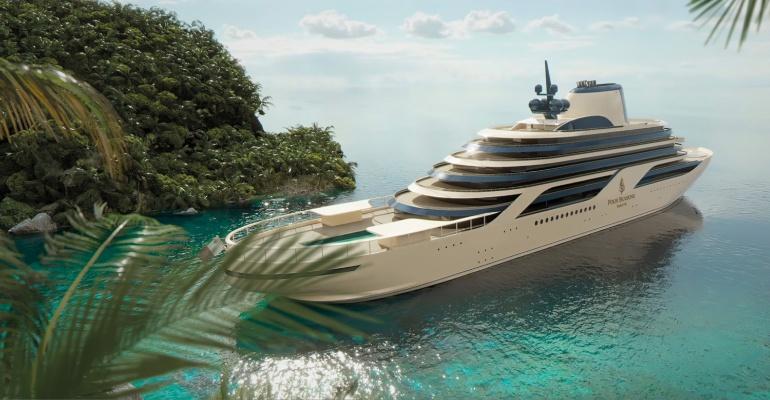The first ship from Four Seasons – jointly owned by Marc-Henry Cruise Holdings – is due to set sail in late 2025, 'combining Fincantieri know-how and leadership on different disciplines and ship types, ranging from luxury cruise vessels to top class yachts.’
Variable-speed engines and direct distribution grid
The GM of Fincantieri’s merchant ships division told Seatrade Cruise, ‘The vessel is based on a diesel electric power plant equipped with four variable-speed engines provided by MAN, capable of generating a maximum power of 14.4 MW, and a propulsive concept based on two azimuth pods with a total power of 7.2 MW.
‘The introduction of variable-speed engines associated with a direct current (DC) distribution grid represents an unprecedented application in the cruise industry,’ he continued. ‘Compared to conventional fixed-speed diesel engines, the variable-speed diesel engine offers several advantages, which make them suitable for various applications, especially where flexibility, efficiency, and performance are essential.’
The main advantages include, for instance: fuel efficiency and reduced emissions - optimization of fuel consumption at different speeds and loads; enhanced performance, suitable for applications where rapid load changes are required; reduced noise and vibration - operation at lower RPMs during periods of low load; extended engine life from less stress during operation at lower loads; load flexibility: adaptation to varying load conditions more effectively than fixed-speed engines.
‘Overall, the advantages of using variable-speed diesel engines in conjunction with a DC grid include enhanced efficiency, precise control, grid stability, and compatibility with hybrid power systems and energy storage,’ Matarazzo explained. DC grids can offer higher overall efficiency compared to alternating current (AC) grids because they eliminate the need for AC-to-DC conversion and reduce losses associated with AC transmission. ‘Variable-speed diesel engines can be more easily synchronized with DC grids, allowing for efficient power conversion and delivery, resulting in better power quality. These engines excel at precise control of power output, which is crucial in DC grids. They can ramp up or down quickly to match the varying power demands of DC loads, making them ideal for applications where load fluctuations are common,’ he specified.
Reducing the environmental footprint
‘The outstanding care for the environment undertaken with Four Seasons vessels is also certified by specific class notations, for instance, “Silent-E,” which ensures ships do not exceed established underwater radiation noise levels, minimizing their impact on marine life,’ Matarazzo remarked, plus, ‘“clean design” which sets more stringent levels for emissions to the air and discharges to the sea than what either the International Maritime Organization or most flag states require.’
With the vessel sailing at a service speed of 15 knots, the target of reducing the propulsive power – and therefore minimizing consumption and emissions – was achieved by first applying the most sophisticated techniques of numerical optimization (CFD) and then testing the scale model in a specialized basin to optimize the hull.
‘The search for efficiency embraces all aspects of ship design,’ Matarazzo asserted, from the installation of variable frequency drives for main electric motors (chiller units, thrusters) to maximize efficiency at partial loads, to the adoption of recovery systems, such as the enthalpy recovery units for the air conditioning. The vessel will be able to connect to shore power at both its starboard and port side.
Improving comfort
Several features have been included in the technical configuration of the Four Seasons design aiming to improve passenger comfort. Main engines and alternators are rigidly mounted on a common base frame, which is then mounted on foundations to dampen the transmission of machine-borne noise and vibrations through the ship structure.
Similarly, all technical plants within the engine casing have been arranged using the so-called ‘suspended casing,’ which enables the prefabrication of modular components to be installed on board fully outfitted and connected to ship structures by means of resilient mountings, thus minimizing the transmission of noise and vibration to adjacent passenger suites.
Matarazzo pointed out that the ‘Passenger experience is also enhanced by adopting an innovative structural design, specifically customized for the Four Seasons project, which enabled the largest openings ever introduced for oceanfront suites on a cruise vessel, with a clear span exceeding four meters.’
Large glazing also characterizes the unique design of the four-level funnel suite. ‘And it goes without saying that the large use of glass is combined with the state-of-the-art technology for reducing solar radiation and heating in indoor spaces’ concluded the GM.
Copyright © 2024. All rights reserved. Seatrade, a trading name of Informa Markets (UK) Limited.
Add Seatrade Cruise News to your Google News feed.  |

